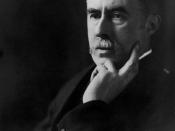A. E. Housman's 'To an Athlete Dying Young,' also known as
Lyric XIX in A Shropshire Lad, holds as its main theme the
premature death of a young athlete as told from the point of view
of a friend serving as pall bearer. The poem reveals the concept
that those dying at the peak of their glory or youth are really
quite lucky. The first few readings of 'To an Athlete Dying Young'
provides the reader with an understanding of Housman's view of
death. Additional readings reveal Housman's attempt to convey the
classical idea that youth, beauty, and glory can be preserved only
in death.
A line-by-line analysis helps to determine the purpose of the
poem. The first stanza of the poem tells of the athlete's triumph
and his glory filled parade through the town in which the crowd
loves and cheers for him. As Bobby Joe Leggett defines at this
point, the athlete is 'carried of the shoulders of his friends
after a winning race' (54).
In Housman's words:
The time you won your town the race
We chaired you through the market place;
Man and boy stood cheering by,
And home we brought you shoulder-high. (Housman 967).
Stanza two describes a much more somber procession. The athlete is
being carried to his grave. In Leggett's opinion, 'The parallels
between this procession and the former triumph are carefully drawn'
(54). The reader should see that Housman makes another reference
to 'shoulders' as an allusion to connect the first two stanzas:
Today, the road all runners come,
Shoulder high we bring you home,
And set you at the threshold down,
Townsman of a stiller town. (967)
In stanza three Housman describes the laurel growing 'early' yet
dying 'quicker than a rose.' (967) This parallels 'the...


